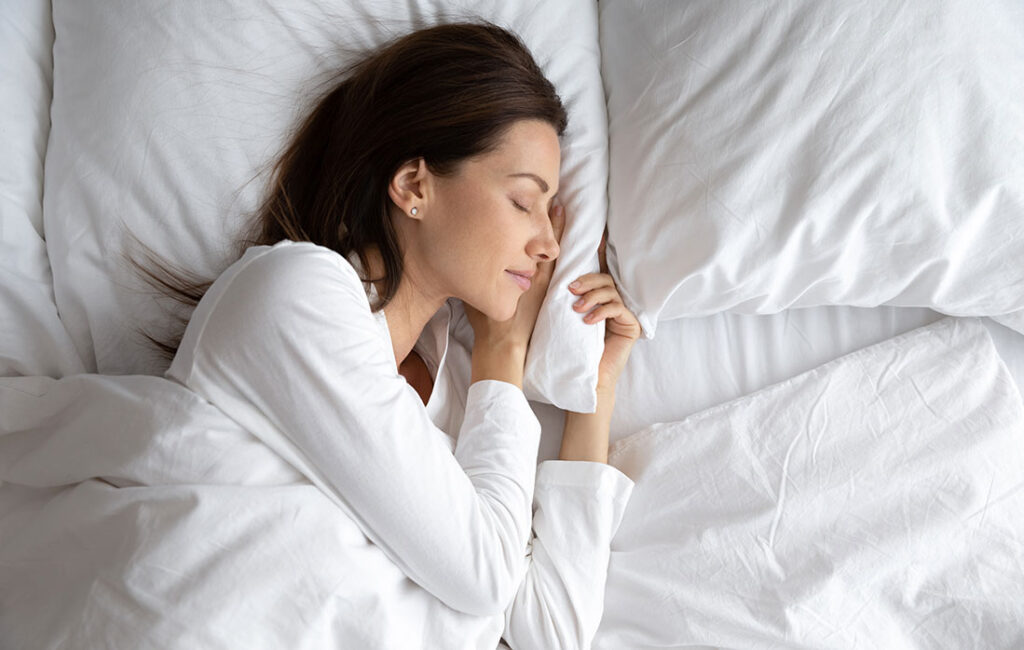
Wrinkles are an inevitability for most of us. And as far as we know, they’re typically caused by a loss of collagen and a decrease in elasticity — over time. But, increasingly, social media influencers are taking to their favorite platforms to shout from the super highway rooftops that side sleepers are fast-tracking their wrinkles as a result of compression night after night. But are sleeping wrinkles fact or fiction? Sleepopolis recently caught up with a few experts to weigh in on whether side sleepers are, in fact, expediting the appearance of wrinkles on their faces.
What Causes Wrinkles?
Long story short, wrinkles are a fact of life, and while some people may begin to see wrinkles as early as their 20s, wrinkles are most often associated with the aging process. On the surface, wrinkles are folds or creases that appear on your face and body. As we peel back the onion, so to speak, we find that wrinkles are typically a result of a decrease in collagen in the dermis (the middle layer of your skin) and less fat in the subcutaneous layer (or deepest layer) of your skin. Pair those with daily exposure to UV radiation and a host of biological, environmental, and genetic factors over time, and boom — wrinkles.
Does Sleeping On Your Side Cause Wrinkles?
For many people, it could take decades for wrinkles to settle in, and the key is time. For others, however, wrinkles may be expedited as a result of their preferred sleeping position. And we hate to be the bearers of bad news, but it looks like the rumors are true, folks. Sleeping on your side can cause wrinkles. But you don’t have to take our word for it.
Dr. Dustin Portela, DO, a Board Certified Dermatologist and Dermatologic Surgeon, says, “Any time you have repetitive stress on the skin, it can take a toll. When you sleep on your side, one side of the face is compressed, and if you do that night after night over a period of years, you will start to see changes on one side of the face that you don’t see on the other.”
Portela explains, “I like to think of it as bending a piece of plastic. The first few times you bend it, it will return to its normal shape, but the further you bend it in, and the more often you do, you’ll start to notice that creases will form through repetitive stress. Eventually, the piece of plastic will not rebound to its original shape. The skin behaves in a similar fashion until, in this case, the wrinkles have appeared and do not go away.”
Dr. Tanuj Nakra, Double Board Certified Plastic Surgeon and Co-Founder of AVYA Skincare, further explains it by drawing a parallel many of us can easily understand: “Sleeping on our side causes all 11 pounds of our head (same as a bowling ball!) to weigh directly on the skin on the side of our face,” he says. “Ultimately, this corrugates the skin in a fixed position for hours, pleating the dermis and causing wrinkles.”
And with one more “yea” for sleep wrinkles, Dr. Shirley Madhère, a holistic plastic surgeon and founder of Jet Set Beauty Rx, says, “It is typically the friction, compression, tension, and shear forces caused by the contact with various bedding that may cause ‘sleep wrinkles.’ And since sleeping on the side or face leads to the most contact with pillowcases, these positions tend to create more of such wrinkles.”
Moreover, not only can side sleeping cause wrinkles, but your dermatologist can tell which side you sleep on just by looking at you.
“When I evaluate somebody for Botox or fillers, I can tell which side they sleep on if they are a side sleeper,” says Portela. “The differences are subtle and unlikely to be noticed by the average person, but as someone who is trained specifically in evaluating and augmenting facial aesthetics, it is easy to identify.”
Dr. Nakra adds, “Sleep line patterns differ from regular wrinkles. I can identify sleep lines on patients I have just met and can easily infer their nighttime sleeping position. Typical facial wrinkles from aging are in patterns related to the underlying facial muscles, whereas sleep lines differ in that they’re parallel to the sleeping position.”
Related: Best Mattress for Side Sleepers
Can Overnight Folds Develop Into Permanent Wrinkles?
We’ve all woken up with folds in our skin from sleeping in a particular position, and of course, those creases are usually short-lived. But the very fact that our skin can fold into a wrinkle begs the question can overnight wrinkles eventually develop into real and permanent wrinkles?
According to Dr. Nakra, the answer is “[Yes] – Overnight folds and wrinkles can absolutely become permanent over time. [Everyone] likes a particular position and relies on it regularly for good sleep. This produces the same exact compression pattern every night, eventually leading to deep and permanent creases.”
Can Sleep Wrinkles Be Prevented?
So, we gave you the bad news; here’s the good news. You can prevent sleep wrinkles, and it’s easier than you might think. The consensus is – sleep on your back.
“The best way to prevent sleep wrinkles is to sleep on your back if that is possible,” says Portela. Of course, Portela recognizes that it may be easier said than done. “Getting good quality sleep is more important than the position that you sleep in, but if you can sleep equally well on your back, it is ideal.” Dr. Madhère adds, “To reduce the effects of tension, compression, and shear forces in the face, consider sleeping on your back with your head slightly elevated.”
Beyond sleeping on your back, the doctors also recommend a few strategic bedding swaps like satin or silk pillowcases and specialized pillows. Dr. Madhère notes that softer bedding like silk and high thread count bedding will likely minimize the friction. Similarly, Dr. Nakra notes, “satin does not grip skin like cotton or other common pillow fabrics, thereby reducing the pull and tug on facial skin during side-sleeping. So, I typically recommend satin pillowcases for all my aesthetically-oriented patients looking to minimize sleep-induced wrinkles.”
Dr. Portela adds that “there are pillows made for side sleepers that take pressure off the sides of the face and distribute them closer to the jawline and the hair-bearing areas of the scalp. That way, there is less pressure on the central and lateral parts of the face, which will contribute to wrinkles and loss of elasticities. One such pillow is the Sleep and Glow.
In one final bit of advice on wrinkling, Dr. Portela reminds us that wrinkles are much more than sleeping on your side and creasing your face. “There are other things that will contribute to facial wrinkling, much more predictably than sleeping on your side,” says Portela. “It’s very important to avoid smoking, avoid unnecessary sun exposure, wear your sunscreen daily, and eat a balanced diet that supports your skin health. These are all factors that are within your control. You may not be able to control what your body does while sleeping, so focus on the things that you have power over.”



























